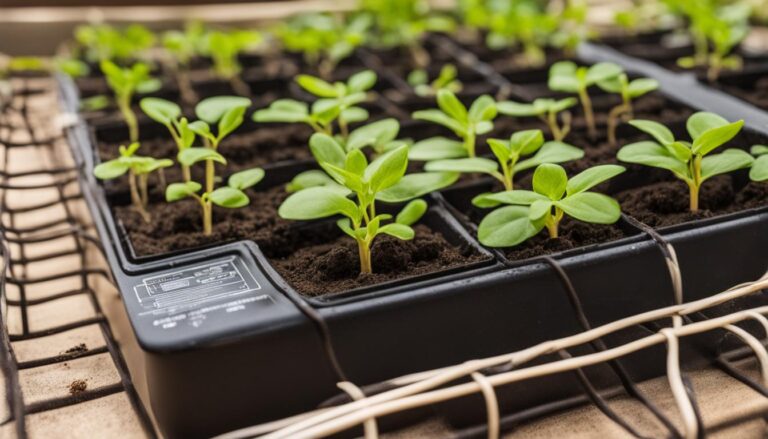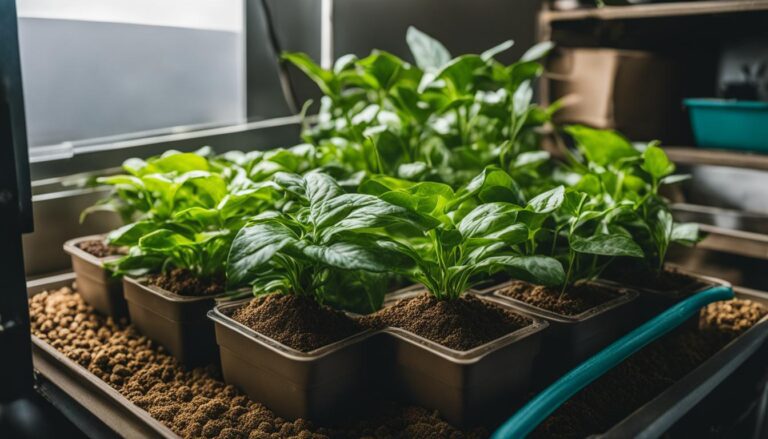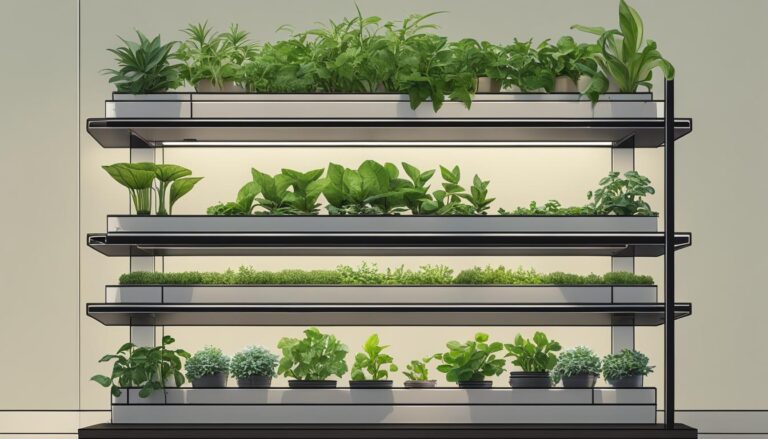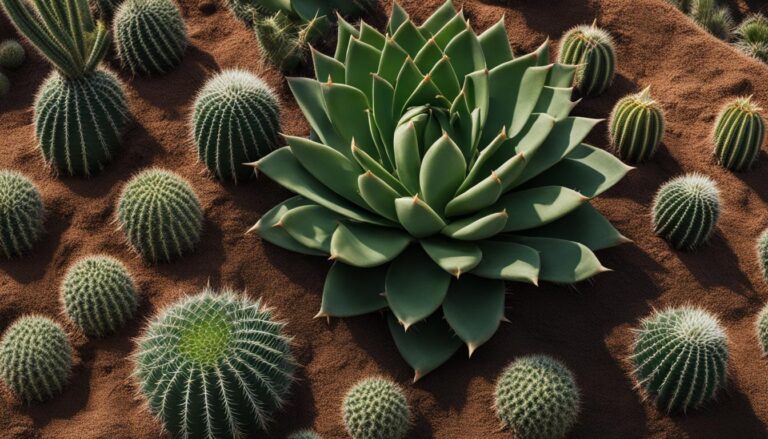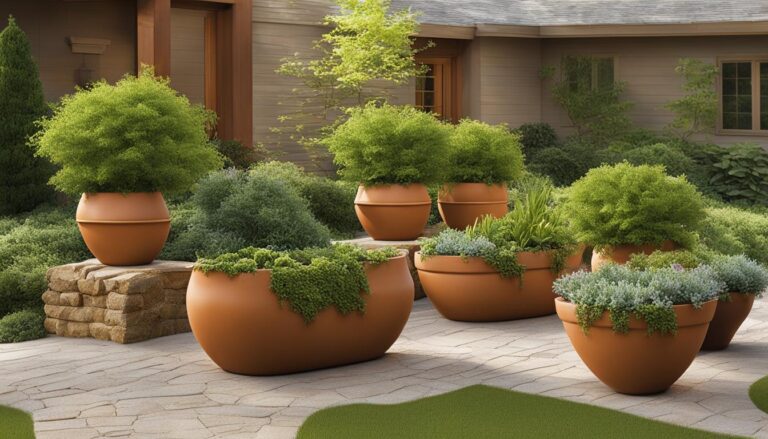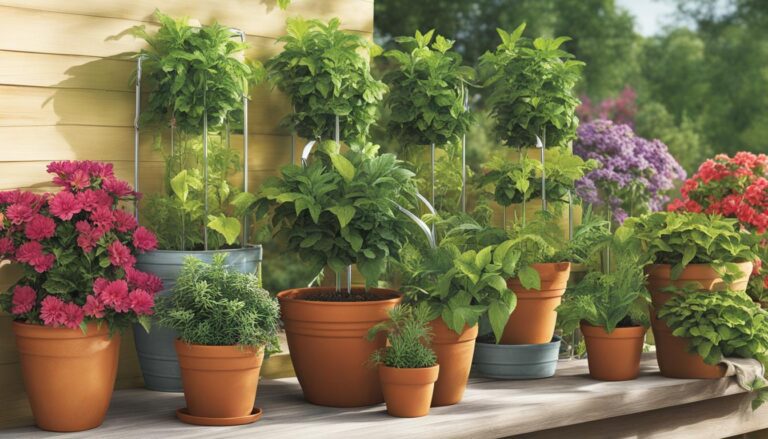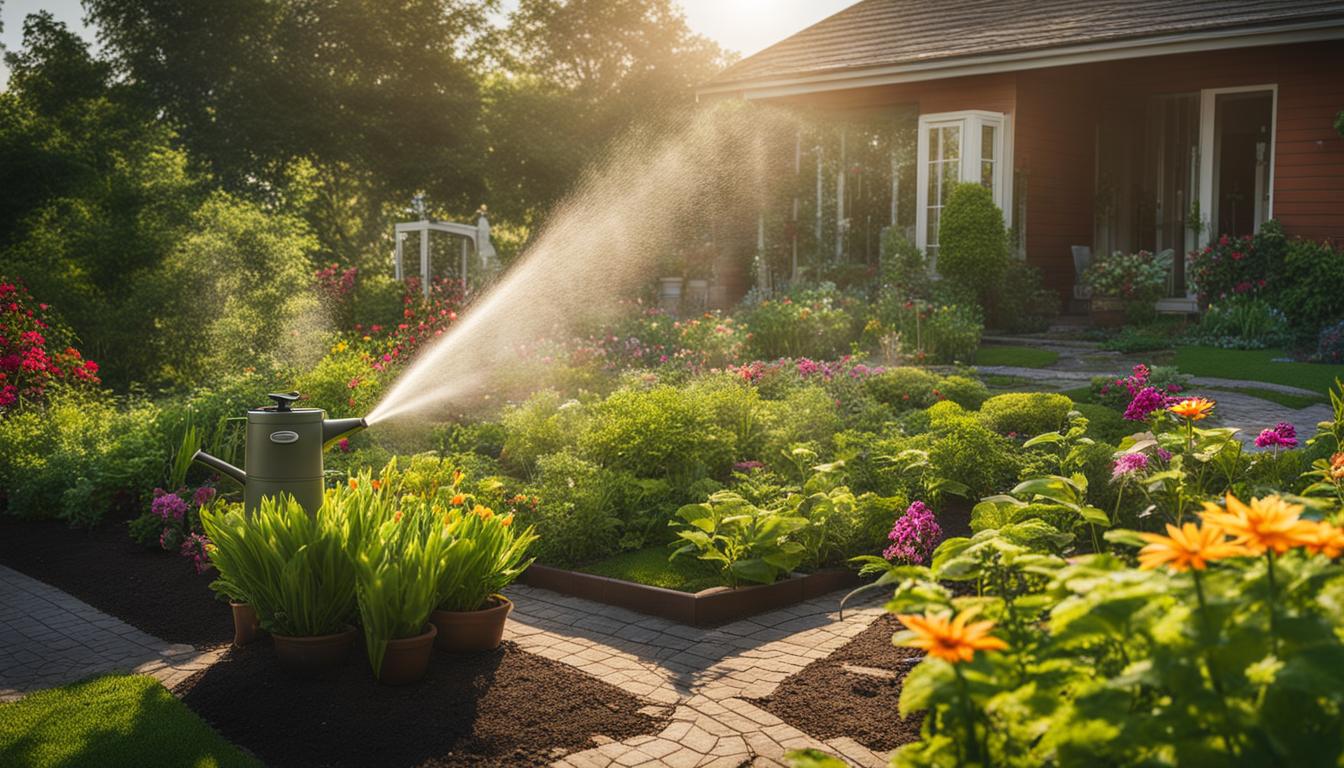
Are you tired of spending countless hours manually watering your garden? If so, it’s time to consider automating the watering process. With the advancements in technology, there are now various solutions available to help you efficiently and effectively water your garden.
From automatic watering systems to smart irrigation, these solutions can save you time and ensure your plants receive the right amount of water.
By automating the watering process for your garden, you can easily customize the watering schedule, adjust water flow, and even utilize alternative water sources such as rainwater or ground water.
Whether you have a small garden or a large plot of land, there is an automated watering system that can meet your needs and simplify your gardening tasks.
Key Takeaways:
- Automating the watering process for your garden saves time and effort.
- Automated systems provide efficient and consistent watering, promoting healthier plant growth.
- Consider factors such as garden size, soil type, and plant watering needs when choosing an automated watering system.
- There are different types of automated watering systems available, including soaker hose systems, drip irrigation systems, and sprinkler systems.
- Installation involves connecting hoses, sprinklers, sensors, and timers according to your garden’s layout.
Benefits of Automating Watering for Your Garden
Automating the watering process for your garden offers several benefits. It saves time and effort as you no longer need to manually water your plants.
With the automation system in place, you can set a watering schedule that suits your plants’ needs and ensure they receive the right amount of water consistently. This promotes healthier plant growth and reduces the risk of underwatering or overwatering.
Automated systems often include features that conserve water, such as rainwater harvesting and moisture sensors. By using these smart gardening solutions, you can efficiently water your garden while also being conscious of water conservation.
One of the main advantages of an automatic watering system is that it provides efficient garden watering. The system can be programmed to deliver the exact amount of water needed by your plants, eliminating guesswork and ensuring optimal hydration.
This not only saves water but also reduces the risk of plant stress and diseases caused by overwatering. By automating the watering process, you can achieve consistent and precise watering, leading to healthier and more vibrant plants.
Time-saving is another significant benefit of automating watering for your garden. Instead of spending time manually watering each plant, you can set up a schedule and let the automated system do the work for you.
This is particularly helpful for busy gardeners who might not have the time or availability to water their plants regularly. With an automatic watering system in place, you can enjoy the convenience of a well-maintained garden without the time-consuming task of manual watering.
Water conservation in the garden
Automating the watering process also promotes water conservation in the garden. By using features like rainwater harvesting and moisture sensors, you can optimize water usage and minimize waste.
Rainwater harvesting allows you to collect and store rainwater, which can then be used to water your plants during dry periods. This reduces the need for tap water and helps preserve this valuable resource.
Moisture sensors, on the other hand, measure the moisture levels in the soil and adjust the watering schedule accordingly. This prevents overwatering and ensures that water is used efficiently, reducing water consumption and promoting sustainability in gardening practices.
In conclusion, automating watering for your garden offers numerous benefits, including efficient and time-saving garden watering, as well as water conservation.
By utilizing automated systems and smart gardening solutions, you can ensure that your plants receive the right amount of water consistently, leading to healthier and more vibrant gardens.
With the added convenience and sustainability of automated watering, you can enjoy a flourishing garden while also reducing your environmental impact.
Choosing the right automated watering system for your garden
When it comes to automating the watering process for your garden, there are several factors to consider in order to choose the right system. Customization, soil type, and garden size are all important considerations that will help ensure the system meets your specific needs.
Factors to consider for automatic watering system
One of the key factors to consider when selecting an automated watering system is customization. Different plants have different water requirements, so it’s important to choose a system that allows you to adjust the watering schedule and flow to meet the specific needs of your garden. Look for a system that offers flexibility and the ability to customize watering settings.
Another important factor to consider is the type of soil in your garden. The type of soil determines how well water is absorbed and distributed to the plants’ roots.
Sandy soil, for example, drains water quickly, while clay soil retains water for longer periods. Understanding the characteristics of your soil will help you choose a system that delivers water effectively.
Garden size is also a crucial consideration. Larger gardens may require more extensive irrigation systems, while smaller gardens can benefit from compact and efficient solutions.
Assess the size of your garden and choose a system that can adequately cover the entire area, ensuring all plants receive sufficient water.
Customizing watering system
Customization is an important feature to look for when selecting an automated watering system. The ability to adjust the watering schedule, duration, and flow rate allows you to tailor the system to the specific needs of your garden and plants.
Some systems even offer advanced features, such as moisture sensors, that automatically adjust watering based on soil conditions. Consider your garden’s unique requirements and choose a system that offers the necessary customization options.
Soil type and watering
The type of soil in your garden plays a crucial role in the effectiveness of your watering system. Sandy soil drains water quickly, while clay soil retains water. This means that the watering schedule and duration may need to be adjusted accordingly.
Take into account the soil characteristics of your garden and choose a system that can deliver water effectively based on your specific soil type.
Garden size and irrigation system
The size of your garden will also dictate the type of irrigation system you need. Larger gardens may require more extensive systems, such as sprinkler systems or drip irrigation, to ensure adequate water coverage.
Smaller gardens, on the other hand, can benefit from more compact and efficient solutions. Consider the size of your garden and choose an irrigation system that can effectively deliver water to all areas of your garden.
| Factors to Consider | Importance |
|---|---|
| Customization | High |
| Soil type | Medium |
| Garden size | High |
Types of Automated Watering Systems
When it comes to automating the watering process for your garden, there are several types of systems to choose from. Each system offers unique features and benefits, allowing you to select the best option for your specific needs. Let’s explore the different types of automated watering systems:
1. Soaker Hose System:
The soaker hose system is a popular choice for gardeners looking for an efficient and cost-effective way to water their plants.
This system consists of permeable hoses that release water directly into the soil, delivering moisture directly to the roots. Soaker hoses are especially beneficial for plants that require consistent and gentle watering.
2. Drip Irrigation System:
Drip irrigation systems are designed to provide slow and precise watering to plants. This system uses narrow tubing with tiny holes or emitters that release water directly at the base of the plants.
Drip irrigation is ideal for gardeners who want to minimize water waste and ensure targeted watering for specific plants or areas of their garden.
3. Sprinkler System:
Sprinkler systems distribute water in a spray pattern over a wider area, making them suitable for larger gardens. These systems can be customized to adjust the spray angle, pattern, and radius to ensure even coverage. Sprinkler systems are versatile and can be used to water both lawns and gardens.
4. Smart Watering System:
A smart watering system utilizes technology to monitor soil moisture levels and adjust watering accordingly. These systems often include sensors that measure soil moisture, rainfall, and evaporation rates.
Based on this data, the system automatically adjusts the watering schedule to ensure optimal water usage. Smart watering systems can be controlled remotely through smartphone apps, making them convenient and user-friendly.
5. Water Timers:
Water timers are commonly used in conjunction with automated watering systems to regulate the frequency and duration of watering. These devices can be programmed to turn the water on and off at specific times, ensuring consistent and efficient watering.
Water timers are available in various styles, from simple mechanical timers to more advanced digital models that offer additional features.
By choosing the right automated watering system for your garden, you can ensure your plants receive the proper amount of water while saving time and resources.
Consider the specific needs of your garden and plants when selecting a system, and explore the different options available to find the perfect fit.
Installing an Automated Watering System
To successfully install an automated watering system for your garden, follow these step-by-step instructions. Begin by gathering all the necessary components, including hoses, sprinklers, sensors, and timers.
Lay out the tubing or hoses according to your garden’s layout, ensuring they reach all areas that require watering. Connect the appropriate sprinklers or drip irrigation devices to the tubing, taking into consideration the specific watering needs of your plants.
Position sensors in strategic locations to monitor soil moisture levels, and connect them to the control unit. Finally, set up timers or controllers to establish the watering schedule. Refer to the manufacturer’s instructions for detailed guidance specific to your chosen system.
When connecting hoses and sprinklers, make sure all connections are secure and leak-free. It’s also important to position sensors at a proper depth to accurately measure soil moisture and trigger the watering system when needed.
Test the timers or controllers to ensure they are programmed correctly and functioning as intended. Regularly check the system for any leaks or blockages, and promptly address any repairs or maintenance needs that arise.
Recommended Steps for Installing an Automated Watering System:
- Gather all necessary components, such as hoses, sprinklers, sensors, and timers.
- Lay out the tubing or hoses according to your garden’s layout.
- Connect the appropriate sprinklers or drip irrigation devices to the tubing.
- Position sensors at appropriate depths to monitor soil moisture levels.
- Connect sensors to the control unit.
- Set up timers or controllers to establish the watering schedule.
- Regularly check the system for leaks, blockages, and proper functioning.
By following these installation steps and ensuring proper connections and placements, you can successfully set up an automated watering system for your garden. This system will provide efficient and consistent watering, saving you time and ensuring your plants receive the right amount of water.
| Component | Installation Step |
|---|---|
| Hoses or tubing | Lay out according to garden layout |
| Sprinklers or drip irrigation devices | Connect to tubing |
| Sensors | Position at proper depth |
| Sensors | Connect to control unit |
| Timers or controllers | Set up watering schedule |
| All components | Regularly check for leaks and functioning |
Water source options for automated watering
When automating the watering process for your garden, you have several water source options to consider. Each option has its own benefits and considerations, allowing you to choose the most suitable water source for your automated watering system.
If you’re looking for a sustainable and eco-friendly solution, rainwater harvesting is an excellent choice. By collecting rainwater in a storage tank or barrel, you can utilize it for watering your garden. This not only conserves tap water but also provides your plants with natural, chemical-free water.
Another water source option is using ground water for garden irrigation. If you have access to a well or a garden pump, you can draw water from underground sources to water your plants. Groundwater is often rich in nutrients, which can benefit the health and growth of your garden.
If rainwater or ground water is not available, you can still use tap water for automated watering. While tap water may contain chemicals such as chlorine, it can still be used effectively in an automated watering system. To minimize water wastage and improve efficiency, consider implementing water-saving features such as moisture sensors and timers.
By considering these water source options and choosing the most suitable one for your garden, you can ensure efficient and sustainable watering for your plants.
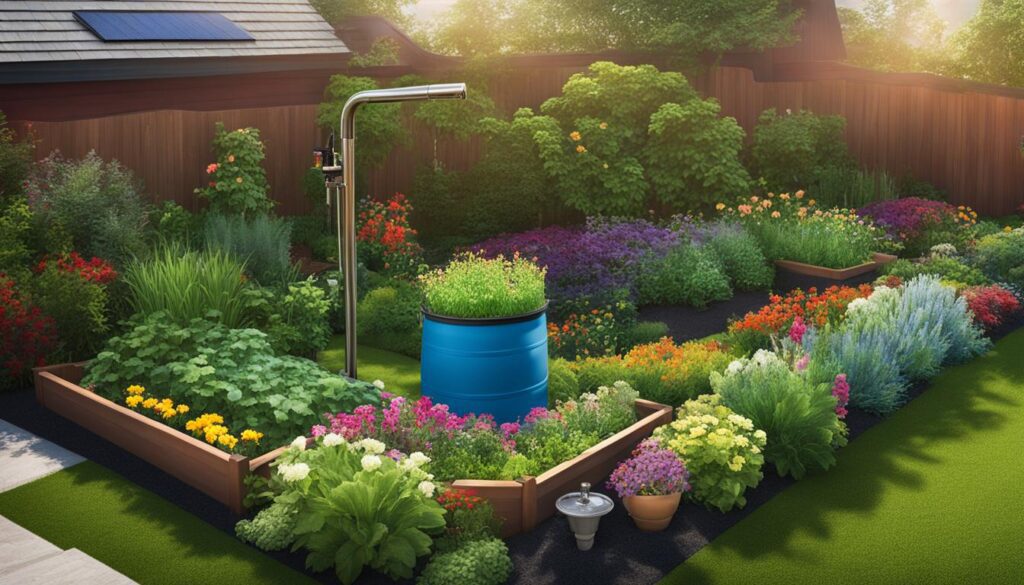
Maintenance and Troubleshooting for Automated Watering Systems
Proper maintenance is essential to ensure the optimal functioning of your automated watering system. Regular inspections and troubleshooting can help identify and resolve issues before they escalate. Here are some important maintenance tasks you should perform:
Checking for Leaks and Damaged Components
- Inspect all hoses, connectors, sprinklers, and timers for leaks or signs of damage.
- Replace any faulty components to prevent water waste and ensure consistent watering.
Cleaning and Unclogging Hoses and Sprinklers
- Regularly clean hoses and sprinklers to remove debris that can clog the system.
- Check for any blockages and use a small brush or toothpick to clear them.
Repairing Timers and Sensors
- Test the programming of timers and sensors to ensure accurate watering schedules.
- Replace batteries or repair any malfunctioning parts to maintain proper functionality.
By performing these maintenance tasks on a regular basis, you can ensure that your automated watering system functions efficiently and effectively, providing optimal water distribution for your garden.
| Common Issues | Possible Solutions |
|---|---|
| Leaking hoses or connectors | Replace damaged components or use hose repair kits to fix leaks. |
| Uneven water distribution | Adjust sprinkler heads or use pressure regulators to ensure balanced water flow. |
| Malfunctioning timers or sensors | Reset or reprogram timers, replace batteries, or repair/replace sensors as needed. |
| Clogged sprinklers or drippers | Clean or replace clogged components to maintain proper water flow. |
Tips for Effective Garden Watering Automation
Proper watering is vital for maintaining a healthy garden. When automating your watering system, there are several tips to keep in mind to ensure optimal plant growth and water efficiency.
1. Watering Frequency and Duration: Determine the watering frequency based on your plant’s needs and the prevailing weather conditions. Monitor the soil moisture levels and adjust the duration of each watering cycle accordingly. During hot and dry periods, increase both the frequency and duration, while reducing them during cooler and rainy seasons.
2. Adjusting Watering Schedule: Be flexible with your watering schedule to adapt to changing conditions. Pay attention to signs of plant stress, such as wilting or yellowing leaves, which may indicate the need for increased watering. Additionally, consider factors like the plant’s growth stage and soil type to fine-tune your watering schedule.
3. Seasonal Watering Adjustments: As the seasons change, adjust your watering practices accordingly. During summer, when water evaporation rates are high, increase the watering frequency. In contrast, during winter, reduce the frequency to prevent overwatering and promote healthy root development.
By following these tips, you can optimize your automated watering system to provide the right amount of water at the right time, ensuring the health and vitality of your garden.
Comparison of Different Watering Frequencies
| Plant Type | Watering Frequency |
|---|---|
| Succulents | Once every 2-3 weeks |
| Vegetables | 2-3 times per week |
| Flowering Shrubs | Once a week |
| Herbs | Every 2-3 days |
Note: The watering frequencies mentioned in the table are general guidelines. Adjust the frequency based on your specific plant’s needs and environmental conditions.
Cost considerations for automated watering systems
When considering automating the watering system for your garden, it’s essential to take the cost into account. The overall cost will depend on various factors, including the type of system you choose, the size of your garden, and any additional features or components you may require.
It’s important to find a balance between cost and functionality to ensure you get the most value out of your investment.
There are budget-friendly watering solutions available for those looking to minimize expenses. DIY garden watering automation is a popular choice for those with limited budgets and the skills to create their own systems.
By sourcing materials and components independently, you can often save money while still achieving the desired automation for your garden.
In the long run, automated watering systems can provide significant savings. By accurately regulating water usage and delivering the right amount of water to your plants, you can reduce water wastage and conserve resources.
Healthy and well-maintained plants have a higher chance of thriving, reducing the need for plant replacements and associated costs.
| Product | Price Range | Features |
|---|---|---|
| Soaker Hose Systems | $15 – $50 | Efficient water delivery, cost-effective |
| Drip Irrigation Kits | $30 – $100 | Precise water distribution, customizable |
| Smart Watering Devices | $50 – $200 | Automated scheduling, moisture sensors |
When comparing different automated watering systems, consider the initial cost, durability, and maintenance requirements. It’s important to choose a system that fits within your budget while also providing the necessary features and functionality to meet your garden’s needs.
By carefully considering the cost and long-term savings, you can make an informed decision and find the perfect automated watering solution for your garden.
Considerations for Specific Garden Needs
In order to effectively automate watering for your garden, it is important to take into account the specific needs of your garden and plants.
Different garden types and plant varieties have unique watering requirements, and customizing your automated watering system accordingly can ensure optimal plant health and water efficiency. Here are some key considerations for specific garden needs:
Automated Watering for Raised Beds
Raised beds offer a convenient way to grow plants in a controlled environment, and automated watering systems can further enhance the efficiency of these gardens.
When selecting an automated watering system for raised beds, consider options that deliver water directly to the roots of the plants. Soaker hoses or drip irrigation systems are excellent choices, as they provide targeted and efficient watering, reducing water waste and promoting healthier plant growth.
Automatic Watering for Container Gardens
Container gardens are popular for their versatility and mobility, and automating the watering process can make caring for these gardens even easier. For container gardens, consider smaller-scale automated watering systems that cater to individual pots or containers. Individual drippers or self-watering pots are effective options, as they deliver water directly to the plants’ roots while avoiding waterlogging or overwatering.
Irrigation Systems for Small Gardens
Small gardens have their own unique requirements when it comes to automated watering systems. These gardens can benefit from compact irrigation systems that efficiently cover the entire area.
Sprinkler systems or drip lines are suitable choices, as they provide even water distribution and minimize water runoff. When selecting an automated watering system for a small garden, consider the size and layout of the garden to ensure proper coverage and efficient water usage.
Customizing Watering for Different Plant Types
Plants have varying water requirements, and customizing your automated watering system based on plant types can ensure each plant receives the right amount of water. Research the specific water needs of the plants in your garden and select an automated system that allows for customization.
This may include adjusting watering frequency, duration, or even using different types of watering methods for different plants. By tailoring your automated watering system to the specific needs of your plants, you can promote healthy growth and reduce the risk of overwatering or underwatering.
Recommended Automated Watering System Products
When it comes to automating the watering process for your garden, it’s crucial to choose reliable and high-quality products. Here are some recommended garden watering automation products that can help you achieve efficient and effective watering:
Quality Automatic Watering Systems
One of the top choices for automated watering systems is the Snip-n-Drip soaker hose system. This system delivers water directly to the roots of your plants, ensuring efficient watering and minimizing water waste. With its customizable features, you can easily adjust the hose layout and water flow to suit your garden’s specific needs.
Reliable Irrigation System Brands
Garden In Minutes offers a range of drip irrigation kits that provide precise and targeted watering for your garden. These kits include all the necessary components, such as tubing, drippers, and connectors, making installation and setup a breeze. With Garden In Minutes, you can trust in the reliability and effectiveness of their irrigation systems.
Smart Watering Devices
WaterEase is a trusted brand that specializes in smart watering devices. Their products utilize advanced technology to monitor soil moisture levels and adjust watering accordingly. With WaterEase, you can achieve optimal water usage and ensure your plants receive the right amount of water at the right time.
| Product | Brand | Description |
|---|---|---|
| Snip-n-Drip Soaker Hose System | Snip-n-Drip | A customizable soaker hose system that delivers water directly to plant roots, minimizing water waste. |
| Drip Irrigation Kits | Garden In Minutes | Precise and targeted watering system with all necessary components for easy installation and setup. |
| Smart Watering Devices | WaterEase | Advanced technology devices that monitor soil moisture levels to ensure optimal watering. |
These recommended products offer reliable and effective solutions for automating the watering process in your garden. Consider your specific needs and preferences when choosing the right automated watering system, and enjoy the convenience and efficiency of a well-designed irrigation system.
Automating the watering process for your garden brings numerous benefits and offers efficient and convenient gardening solutions. By implementing an automated watering system, you can save time and effort, as well as ensure consistent and optimal water distribution to your plants.
The key benefits of automating garden watering include efficient water usage, as automated systems allow you to customize watering schedules and adjust water flow based on your plants’ needs. This not only promotes healthy plant growth but also conserves water, which is crucial for sustainable gardening.
For successful automated watering, it is important to choose the right system based on your garden’s specific needs, such as the type of plants, garden size, and soil conditions. Additionally, regular maintenance and troubleshooting of the system will help ensure its proper functioning and avoid any water waste or inefficiencies.
To achieve optimal results, it is recommended to monitor and adjust your watering schedule based on factors like weather conditions and seasonal changes. By following these tips and guidelines, you can enjoy the convenience and effectiveness of an automated watering system, leading to a flourishing and beautiful garden.
FAQ
How do I automate watering for my garden?
You can automate watering for your garden by utilizing various solutions such as garden watering automation systems, automatic watering systems, and smart irrigation systems. These systems provide efficient and consistent watering, saving you time and ensuring your plants receive the right amount of water.
What are the benefits of automating watering for my garden?
Automating watering for your garden saves time and effort as you no longer need to manually water your plants. It also promotes healthier plant growth, reduces the risk of underwatering or overwatering, and often includes water conservation features such as rainwater harvesting and moisture sensors.
How do I choose the right automated watering system for my garden?
When choosing an automated watering system, consider factors such as your garden’s specific needs, the type of plants you have, the size of your garden, and the type of soil. This will help you select a system that allows for customization and meets your garden’s unique requirements.
What types of automated watering systems are available?
There are several types of automated watering systems available, including soaker hose systems, drip irrigation systems, sprinkler systems, and smart watering systems. Each system has its advantages, and the choice depends on your garden’s specific needs and your personal preferences.
How do I install an automated watering system?
To install an automated watering system, start by mapping out your garden and determining the placement of each component. Connect hoses, sprinklers, sensors, and timers following the manufacturer’s instructions. Set up timers or controllers to establish the watering schedule.
What are the water source options for automated watering?
You can utilize rainwater harvesting, ground water from a well or garden pump, or tap water in your automated watering system. Rainwater harvesting and utilizing ground water promote water conservation, while tap water can be used efficiently with water-saving features such as moisture sensors and timers.
How do I maintain and troubleshoot my automated watering system?
Regularly inspect the system for leaks or damaged components, clean and unclog hoses and sprinklers, and check the programming of timers and sensors. This will help ensure proper functioning and efficient watering.
What tips can help me effectively automate watering for my garden?
Determine the appropriate watering frequency and duration based on your plants’ needs and prevailing weather conditions. Adjust the watering schedule and duration accordingly. Regularly monitor your garden’s watering needs and make necessary adjustments for optimal plant health.
What are the cost considerations for automated watering systems?
The cost of an automated watering system varies based on the type of system, garden size, and additional features. While there may be an initial investment, consider the long-term savings from efficient water usage and healthier plants.
How do I address specific garden needs with automated watering?
Consider the specific needs of raised beds, container gardens, or small gardens, and select automated watering systems that deliver water directly to the roots or efficiently water the entire area. Customization is key to effective automated watering.
What are some recommended automated watering system products?
Recommended brands and products include soaker hose systems from Snip-n-Drip, drip irrigation kits from Garden In Minutes, and smart watering devices from WaterEase. Research customer reviews and ratings to ensure the chosen products meet your expectations.
What are the key takeaways from automating watering for my garden?
Automating watering for your garden offers numerous benefits such as time-saving, efficient water usage, and healthier plants. By choosing the right automated watering system, considering your garden’s specific needs, and following proper maintenance and watering practices, you can achieve hassle-free gardening and an effective automated irrigation system.

